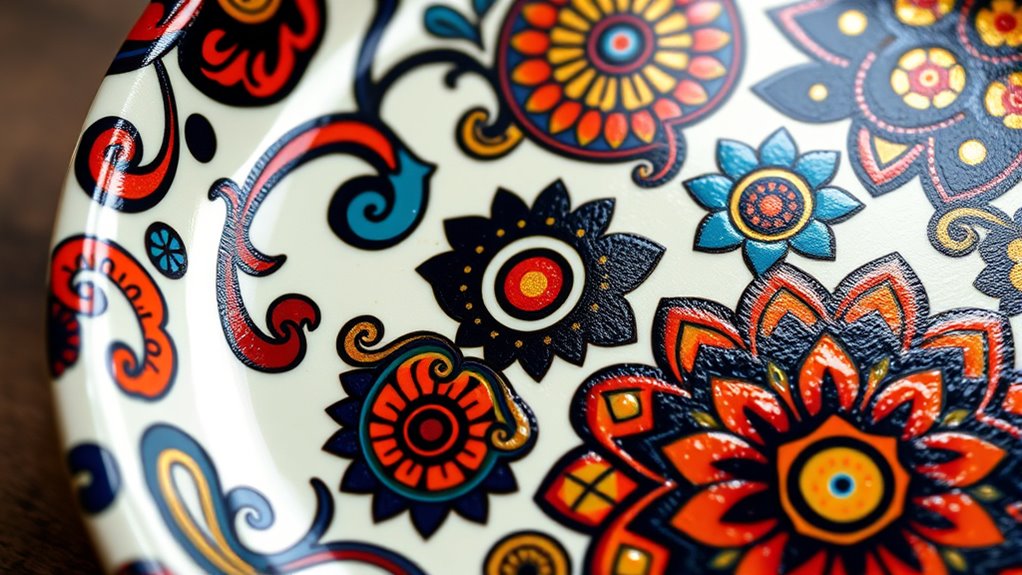Hand-painted patterns inspired by global folk art feature vibrant motifs that reflect community stories, beliefs, and cultural symbols. These designs often incorporate traditional techniques like wax resist or natural dyes, creating intricate, meaningful patterns. From African textiles and Eastern European embroidery to Latin American ceramics, each style carries unique symbolism and craftsmanship. Exploring these motifs reveals rich cultural identities. Keep exploring to discover how contemporary artists reimagine these timeless designs in modern art forms.
Key Takeaways
- Hand-painted patterns often feature motifs like stars, spirals, trees, and sun symbols rooted in cultural and spiritual symbolism.
- Global folk art motifs are inspired by regional techniques such as batik, embroidery, and natural dyeing methods.
- Designs reflect community beliefs, historical narratives, and identity through visual storytelling and symbolic imagery.
- Modern reinterpretations blend traditional motifs with contemporary styles, colors, and experimental media for cultural preservation.
- These patterns serve as visual languages conveying cultural values, hopes, fears, and spiritual connections across diverse communities.
The Cultural Significance Behind Folk Art Motifs
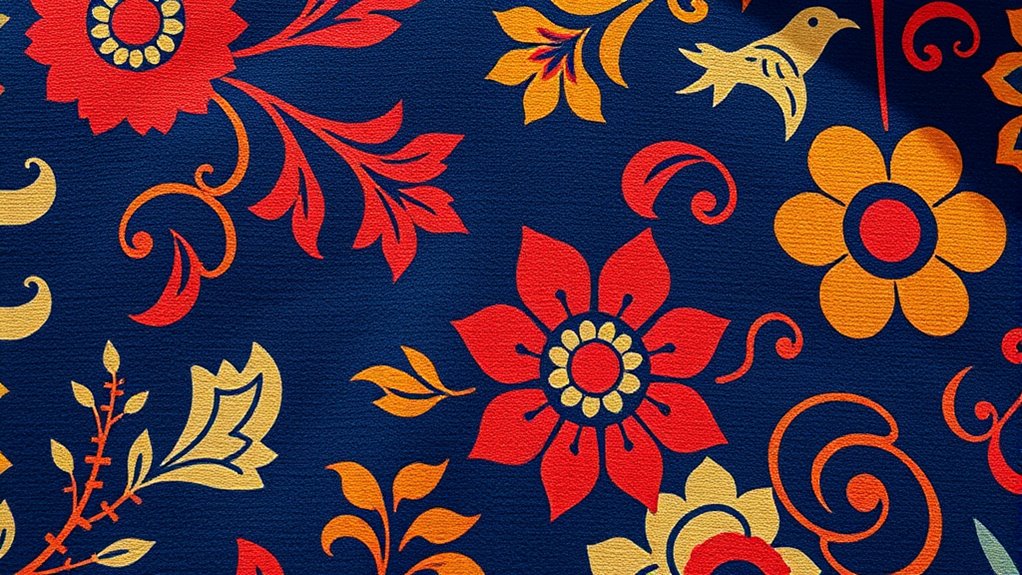
Folk art motifs are more than just decorative patterns; they serve as powerful symbols that reflect a community’s beliefs, history, and identity. Through cultural storytelling, these designs pass down traditions and shared experiences across generations, acting as visual narratives. Many motifs also carry ritual symbolism, representing spiritual beliefs, rites of passage, or protection from harm. When you see these patterns, you’re witnessing more than artistry—you’re observing the language of a community’s soul. Each motif is carefully chosen to convey specific meanings, connecting people to their heritage and reinforcing collective values. Understanding cultural symbolism behind these patterns offers deeper insight into the community’s worldview and the stories they cherish most deeply. Recognizing the astrological signs associated with certain motifs can also provide additional layers of meaning within a community’s folk art. Additionally, knowledge of geographical influences helps explain variations in motifs across regions, revealing how local environments shape artistic expression.
Techniques and Materials Used in Hand-Painting Folk Designs

You’ll find that traditional painting techniques often involve simple tools and carefully controlled brushwork. Natural and synthetic pigments are both used, each offering different qualities and vibrant colors. Understanding these materials helps you appreciate the craftsmanship behind folk design paintings. For example, electric power can sometimes be integrated into traditional art techniques for innovative effects or conservation purposes. Additionally, knowledge of pigment composition is crucial for preserving and restoring folk art works over time. Recognizing regional variations in motifs can also deepen your appreciation of diverse cultural influences in folk art. Moreover, incorporating sound design techniques can enhance the presentation of folk art exhibitions or multimedia projects exploring cultural heritage.
Traditional Painting Techniques
Traditional hand-painting techniques rely on a variety of tools and materials that have been passed down through generations. You might use batik techniques, applying wax and dye to create intricate patterns on fabric, or fresco painting, where pigments are applied directly onto wet plaster for durable murals. These methods require skill and patience, emphasizing craftsmanship. Batik involves melting wax to resist dye, revealing vibrant designs after dyeing and boiling away the wax. Fresco painting demands precise timing, as pigments bond with plaster as it dries. Both techniques highlight a deep understanding of materials and processes, preserving cultural heritage. Whether working on textiles or walls, these traditional methods connect you to a rich history of folk art and craftsmanship.
Natural and Synthetic Pigments
Have you ever wondered what gives hand-painted folk designs their vibrant and enduring colors? The answer lies in the use of natural dyes and synthetic pigments. Natural dyes come from plants, minerals, and insects, offering earthy tones that age beautifully over time. They’re prized for their authenticity and connection to tradition. Synthetic pigments, on the other hand, are man-made and provide brighter, more consistent colors that are easier to work with. Artists often combine both to achieve desired effects, balancing tradition with practicality. The choice of pigments influences the texture, opacity, and longevity of the design. Whether using natural dyes or synthetic pigments, understanding their properties helps you create folk art that is both vibrant and resilient, honoring the rich cultural heritage behind each pattern.
Inspiration From African Textile Patterns
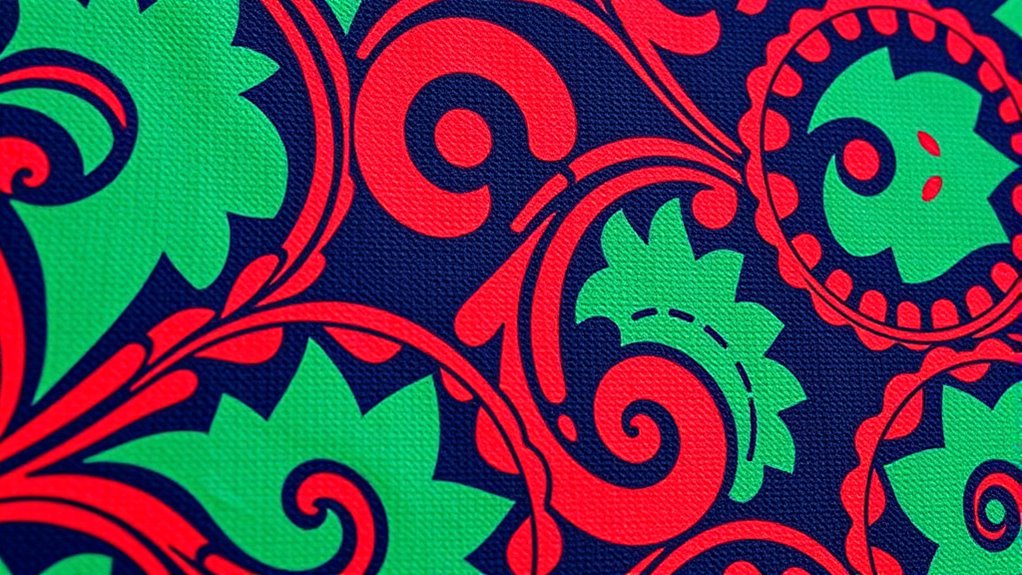
African textile patterns serve as a rich source of inspiration for hand-painted designs, offering a vibrant vocabulary of shapes, colors, and motifs. Adire textiles from Nigeria showcase bold, intricate patterns created through tying, dyeing, and resist techniques, inspiring artists to replicate their striking contrasts and repetitive motifs. Similarly, mud cloth from Mali features geometric symbols and earthy tones that evoke a sense of tradition and storytelling. These textiles often incorporate symbols representing proverbs, spiritual beliefs, and community identity, giving your work depth and cultural resonance. By studying these patterns, you can adapt their rhythmic lines and symbolic motifs into your own hand-painted pieces, creating designs that honor African craftsmanship while adding a layer of meaningful storytelling to your art. Additionally, exploring traditional fabric dyeing methods can deepen your understanding of the techniques and cultural significance behind these motifs, enriching your artistic repertoire. Engaging with global folk art can further broaden your stylistic influences and inspire innovative interpretations within your work. Understanding cultural symbolism can help you incorporate deeper meanings into your designs, elevating them beyond aesthetics to storytelling, and exploring historic preservation can offer insights into maintaining the integrity of traditional patterns in contemporary art.
Eastern European Embroidery and Its Artistic Motifs
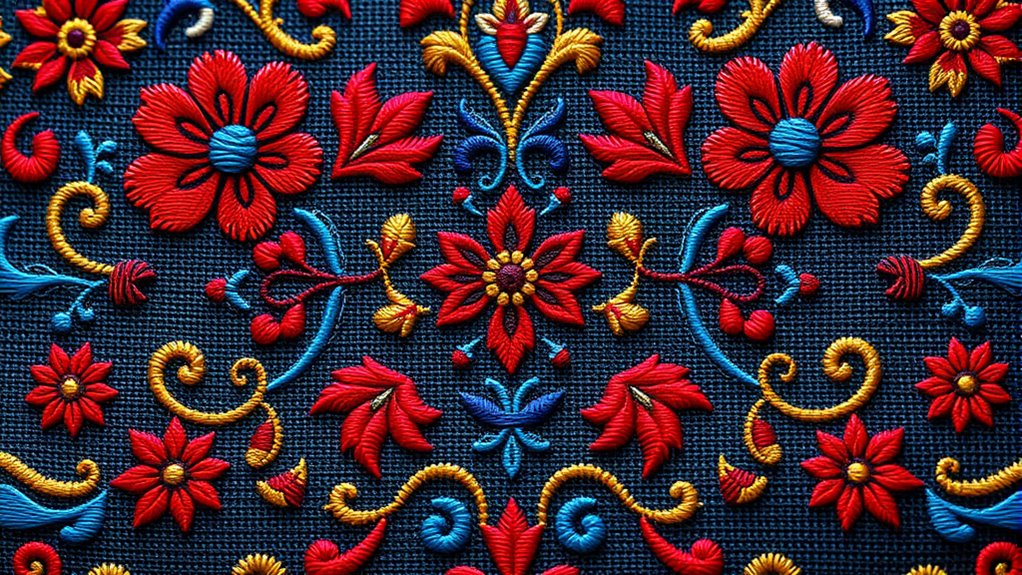
Eastern European embroidery is renowned for its intricate motifs and vibrant patterns that reflect cultural identity and regional history. You’ll notice the skillful use of embroidery stitches, which create textured and detailed designs that have been passed down through generations. The motif color palettes often feature bold reds, blues, greens, and blacks, each symbolizing specific meanings or regional traditions. These motifs typically include geometric patterns, floral elements, and symbolic figures, all carefully stitched to convey stories or beliefs. As you study these textiles, you’ll see how the combination of embroidery stitches and carefully chosen colors transforms fabric into a storytelling canvas. The geometric patterns used in these textiles often have deep symbolic meanings, connecting them to broader cultural narratives. These motifs are also influenced by cultural symbolism, which enriches their significance and adds layers of interpretation to each piece. Additionally, the use of bold colors enhances the visual impact and cultural expression of the textiles. The integration of traditional techniques with contemporary art continues to keep this rich heritage alive and relevant in modern design practices. This vibrant tradition is often preserved through cultural preservation efforts that aim to maintain traditional craftsmanship. This rich tradition continues to inspire contemporary artists, blending historical motifs with modern design sensibilities.
Latin American Ceramic and Pottery Patterns
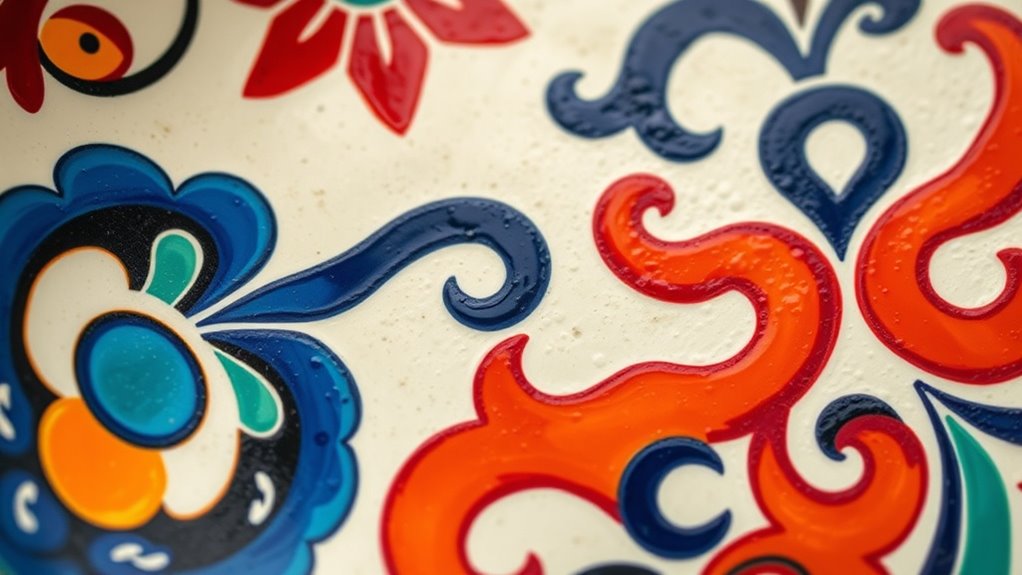
Latin American ceramic and pottery patterns are known for their vibrant color schemes that catch your eye. These designs often feature symbolic motifs that hold cultural significance and tell stories. By exploring these patterns, you can appreciate how colors and symbols reflect local traditions and beliefs. Additionally, understanding the color schemes used in these patterns can deepen your appreciation for their artistic and cultural value. Many of these patterns are inspired by artistic influences that have evolved over centuries, blending indigenous and colonial elements to create unique visual expressions. Recognizing how cultural significance is embedded in these motifs can further enrich your understanding of their importance.
Vibrant Color Schemes
Have you ever noticed how Latin American ceramics burst with bold, lively colors that immediately catch your eye? These vibrant color schemes rely on a keen sense of color harmony, balancing bright reds, blues, greens, and yellows to create eye-catching designs. Artists skillfully use traditional dye techniques, such as natural dyes derived from plants and minerals, to achieve intense, lasting hues. The interplay of contrasting and complementary colors enhances the visual impact, making each piece stand out. These ceramics reflect a cultural celebration of life and nature, where every color choice is deliberate and meaningful. By mastering dye techniques and color harmony, artisans produce pottery that not only serves a functional purpose but also becomes a striking work of art.
Symbolic Motif Significance
Symbolic motifs play a essential role in Latin American ceramics and pottery, serving as visual stories that convey cultural beliefs, histories, and traditions. These patterns often reflect a community’s cultural identity, showcasing symbols passed down through generations. Many motifs carry spiritual symbolism, representing divine forces, protection, or ancestral spirits. By incorporating these symbols into their work, artisans honor their heritage and reinforce shared values. You’ll notice that each pattern isn’t just decorative but deeply meaningful, connecting the maker and the viewer to a larger spiritual or cultural narrative. These motifs act as a visual language, expressing collective identity and beliefs in a way that transcends mere aesthetics. Understanding their significance helps you appreciate the rich cultural tapestry woven into Latin American ceramics.
The Role of Symbolism in Folk Art Motifs
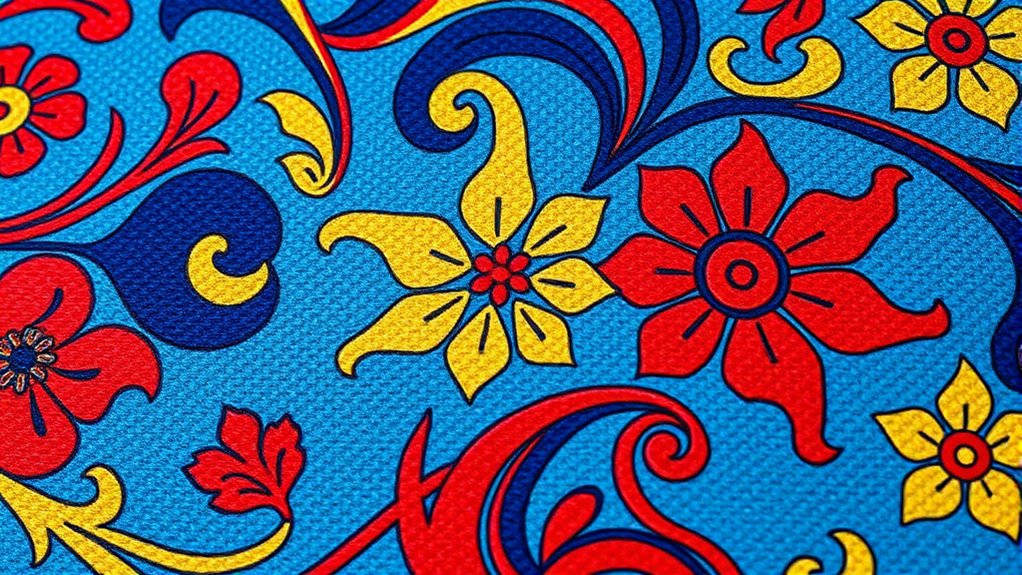
Folk art motifs often serve as visual language, conveying meanings that go beyond their decorative appeal. You’ll notice that each pattern carries symbolic meanings rooted in cultural symbolism, reflecting values, beliefs, and traditions. These symbols help tell stories or express hopes, fears, and identity. For example, a star might symbolize guidance, while a spiral could represent growth. Understanding these symbols deepens your appreciation of the art’s significance. The table below illustrates some common motifs and their meanings:
| Motif | Symbolic Meaning | Cultural Symbolism |
|---|---|---|
| Heart | Love, compassion | Universal, often spiritual |
| Tree | Life, fertility | Ancestral connection |
| Sun | Vitality, energy | Prosperity, enlightenment |
| Anchor | Stability, hope | Maritime communities |
A grasp of cultural symbolism enhances your ability to interpret the deeper significance behind folk art motifs and appreciate their role in preserving heritage.
Modern Interpretations of Traditional Folk Designs
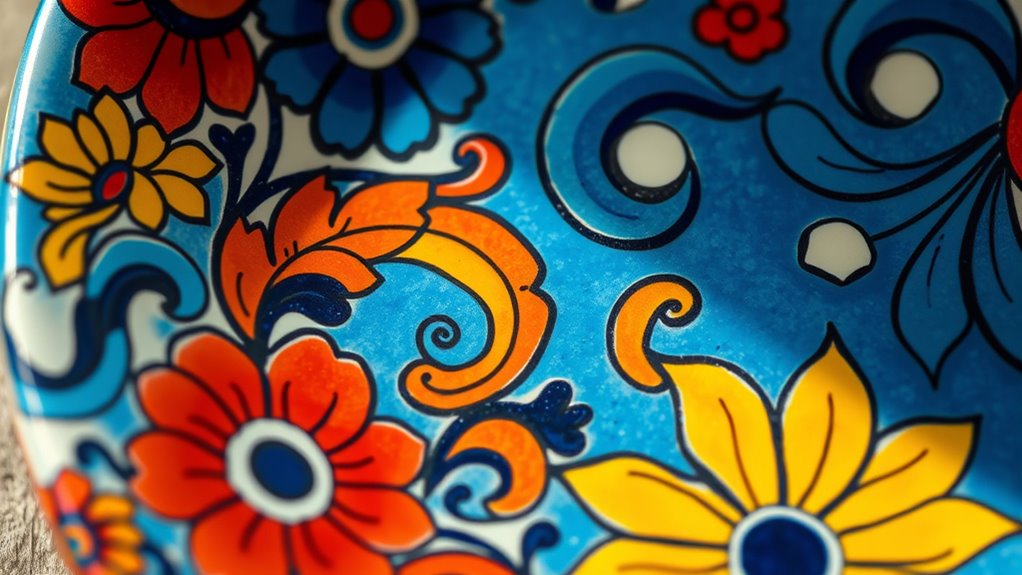
Modern artists frequently adapt traditional folk designs, infusing them with contemporary themes and personal expressions. You’ll notice digital reinterpretations playing a significant role, where technology enables seamless blending of old and new. These reinterpretations often feature vibrant colors, abstract forms, and experimental techniques that reflect today’s cultural landscape. Through this process, a contemporary fusion emerges, merging traditional motifs with modern aesthetics to create fresh visual narratives. You might see hand-painted patterns transformed into digital illustrations or incorporated into multimedia art, allowing for wider reach and innovative presentations. By reimagining folk designs in contemporary contexts, artists keep these patterns alive, making them relevant for new audiences. This approach celebrates heritage while pushing creative boundaries, ensuring traditional motifs evolve without losing their cultural essence.
Preserving and Promoting Folk Art Through Contemporary Art
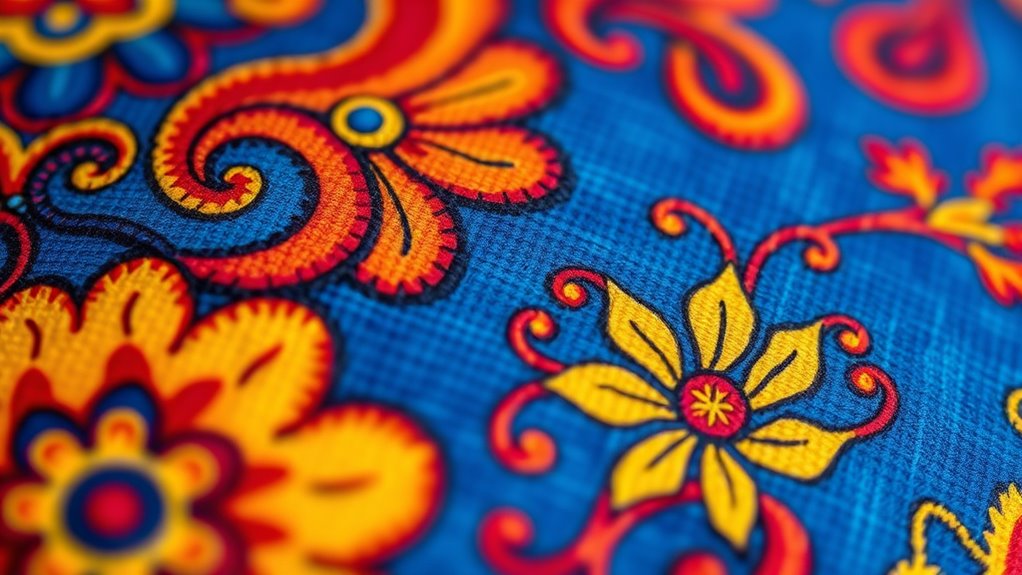
Contemporary artists play a pivotal role in preserving and promoting traditional folk art by reinterpreting its motifs through innovative techniques and platforms. They incorporate folk designs into urban landscapes, transforming cityscapes with vibrant patterns that celebrate cultural heritage. Through collaborations with fashion designers, folk art influences contemporary fashion, making traditional motifs relevant today. This approach helps keep folk art alive, attracting new audiences and fostering appreciation. By blending old and new, artists create a dialogue between tradition and modernity.
| Folk Art Preservation Strategies | Impact on Modern Culture |
|---|---|
| Urban landscape murals | Revitalize city spaces |
| Folk motifs in fashion | Promote cultural awareness |
| Exhibitions and galleries | Educate and inspire |
| Digital platforms | Reach global audiences |
Frequently Asked Questions
How Do Folk Art Motifs Influence Contemporary Fashion?
You see how folk art motifs influence fashion by adding rich cultural symbolism to designs. They inspire contemporary creators to incorporate traditional patterns into modern pieces, fostering unique fashion integration. This blending celebrates cultural heritage while making styles more vibrant and meaningful. As you wear these motifs, you carry stories and symbolism from around the world, making your fashion statement not just stylish but also culturally expressive and globally connected.
Are There Regional Differences in the Symbolism of Folk Patterns?
You’ll notice that regional symbolism varies widely across folk patterns, reflecting distinct cultural variations. In one area, motifs might symbolize nature or spiritual beliefs, while in another, they represent social status or community identity. These cultural differences influence how patterns are understood and used, making each region’s folk art unique. Recognizing these variations helps you appreciate the rich diversity in folk art and its deep-rooted cultural meanings.
Can Hand-Painted Folk Designs Be Customized for Personal Use?
You might think customizing folk designs ruins their cultural authenticity, but in reality, it opens doors for personal expression. Imagine a pattern that once told a community story now tailored for your unique story. Through artisan collaboration, you can personalize these motifs while respecting their roots. This blend preserves tradition and makes it meaningful to you, proving that customization doesn’t dilute, but rather enriches, the cultural tapestry.
What Challenges Do Artists Face in Preserving Traditional Motifs?
You face challenges in preserving traditional motifs as cultural erosion threatens their authenticity. As you adapt designs for modern tastes, it becomes harder to maintain the integrity of original patterns, risking loss of cultural significance. Balancing innovation with authenticity preservation requires dedication, as you work to keep these motifs meaningful and true to their roots despite external influences. This ongoing effort is essential to safeguarding cultural heritage for future generations.
How Has Digital Technology Impacted Folk Art Preservation?
Digital technology has transformed folk art preservation by creating digital archives that store and share traditional motifs worldwide. You can now access virtual exhibitions, broadening awareness and appreciation of folk art’s cultural significance. This tech also helps protect endangered motifs from fading by providing a permanent, easily accessible record. Through these innovations, you actively contribute to the ongoing preservation and appreciation of global folk art traditions in a modern, connected world.
Conclusion
By embracing these hand-painted motifs, you connect with a rich tapestry of global culture and history. These designs aren’t just pretty patterns—they’re stories, symbols, and traditions woven into every stroke. As you explore and preserve folk art, you become part of a living legacy that transcends borders. Don’t let these vibrant traditions fade away; let them inspire your creativity and remind you that beauty and meaning are rooted in our shared human spirit.
